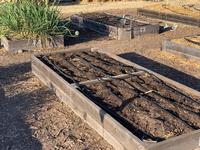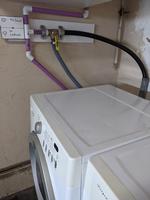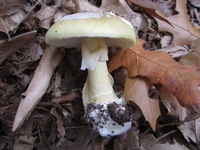Irrigation
Using the right type of irrigation method for your garden ensures a steady water supply for your plants with the least amount of water wastage. Installing an irrigation system provides a more controlled method of delivering water to your garden. Below is a collection of our monthly tips that relate to irrigation.
Irrigation Tips
Drip Irrigation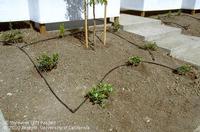
Low volume drip irrigation system
- Water is placed more accurately and efficiently in the root zone, it is applied at a slow rate that reduces loss from runoff. The key to success is watering long enough to supply adequate water to the root zone. Inappropriate watering commonly damages landscape plants. As with any irrigation system, they are efficient only when soil around the plants being irrigated is regularly monitored for proper moisture levels (Reference: UC Pest Note Poor Water Management, Poor Drainage). |
Drought Tip - Irrigate EfficientlyWater restrictions are being put into place all over the state due to the current drought. With over half of urban water used in landscapes, it is essential to make sure your irrigation system is efficient. Watch your plants for signs of underwatering, overwatering, or uneven watering. Consider reducing irrigation times. And make sure your water bill hasn’t unexpectedly jumped. Also, adjust systems on timers monthly as the weather changes or use an automatically-adjusting smart controller. A smart controller can make the needed adjustments after initial programming with plant, location, and other relevant information. Our Santa Clara County clay soil absorbs water slowly, so only water for a few minutes at a time to avoid runoff. Then repeat until the water penetrates to the depth of the roots. Inspect drip and sprinkler systems regularly to make sure there are no leaks, emitters are not clogged and it is watering the plants and not the sidewalk, also make sure the water is going to the root zones of the plants. If you run a hose to a plant, set a kitchen or cell phone timer so you don’t forget that the water is running. Valley Water can help residents with Water Wise Outdoor Surveys and Landscape Rebate Programs.
More information: Irrigation System Audit |
Drought Tip - Laundry to Landscape IrrigationA laundry to landscape system is an easy way to save water in times of drought. It can be installed easily at a low cost to send rinse water from clothes washers directly to the landscape.
Suitable plants include fruit and ornamental trees, shrubs, and ornamental annuals. It’s not applicable where the water would come in direct contact with fruits or vegetables. More information: Laundry-to-Landscape Graywater System
|
Drought Tip - Trees Come First during Drought
More information: Tips to Keep Trees Alive
|
Fall IrrigationYou can still expect some warm weather during October, so keep watering the garden until the fall and winter rains begin. As temperatures drop, less water is needed for plants. Check your soil periodically by digging gently into the soil next to the root, about 6 inches down (deeper for bigger plants). If the soil does not hold a shape when squeezed it is too dry; if it continues to hold shape after the pressure is released it is too wet; if the soil has a shape then crumbles quickly, it has the right amount of water. Hydrozone any new plantings by putting plants with similar water needs together. This helps ensure that less water is wasted and that all plants get the right amount of water. If you have an automatic watering system, this is a good time to inspect the system for leaks and blockages, check the timer for batteries, and reprogram the system as necessary for cooler weather and rain. If you don't have an automatic watering system, think about installing one. Many systems are very affordable and easy to install by the home gardener. Take a look at some "smart meters". They are more expensive, but incorporate weather conditions, your location, and your soil into the programming, making them very efficient. |
Irrigate in Circles and Spirals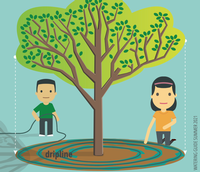
For more information: Help Your Trees Survive the Drought |
Lawn Care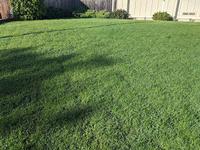
Make sure you are mowing to a height appropriate for your type of grass. Mow frequently enough so that only one-third of the leaf is removed at any one time. Fertilizing is important, even if you are grasscycling, which only provides about 20% of a lawn's fertilizer needs. Grass is all leaf so the primary nutrient needed is nitrogen. Keep on top of weed removal. Thatch is the layer of living and dead grass material (blades, rhizomes, stolons) that can build up on the surface of the lawn. A thin layer protects the soil surface and shallow roots from drying out from the sun, but a thick layer prevents water from getting through. You can remove dead grass material on the soil surface with a special thatch rake to allows water to reach the roots more easily. More Information: The UC Guide to Healthy Lawns |
MushroomsSometimes it seems like there are mushrooms all over: mushrooms in the lawn; mushrooms on the trees; mushrooms in fertilizer; mushrooms in the woods; there is even mushroom compost available. How do you know which mushrooms are desirable and which are not? This can be a life or death determination, both for you and for your plants. Mushrooms are the fruiting bodies we see of fungi which can be widespread and hidden underground or inside plants. Fungi play a beneficial role in decomposition and in providing nutrients to garden plants. Mushrooms in the lawn can be a sign of overwatering, so check the irrigation and drainage. You don't need to remove the mushrooms except to protect young children and pets from eating them. If cultivating or harvesting mushrooms to eat, be sure that you know it is not a poisonous variety.
More information: Mushrooms in lawns
|
Water BudgetingWe always need to use water wisely. Sometimes it is necessary to stop and think about your landscape and prioritize water use. Trees are a long-term investment, yet mature trees may have extensive root systems enabling them to find enough water on their own. Fruit trees may need watering approximately monthly during the summer in order to produce good fruit. Vegetables should always be given adequate water in order to fulfill their purpose in the garden; otherwise the little bit of water you used will have been wasted if the garden is not feeding you well. It’s helpful to understand that home-grown vegetables use much less water overall than ones purchased at the store. Established flowering shrubs, especially California natives, tend to need less water than annual flowers and maybe a more water-efficient way to have color and beauty in your garden. Lastly, keep the weeds under control so that they don’t rob water from the plants that you actually want.
More Information: Water Use Classification of Landscape Species (WUCOLS)
|
Water the Roots, Not the PlantsIt's tempting to get the hose out and spray your dry, thirsty plants, but you don't want to waste water. Keep their feet nice and cool, but resist the urge to squirt the leaves unless they need a cleaning (for dust or white fly for instance). It's a common belief that daytime water on the leaves will burn them. While it's possible, according to scientists—for hairy leafed plants where water droplets are held above the leaf surface—but not very likely. It's more the water will simply evaporate and not do your plants much good and could encourage fungal pathogens if wet overnight. |
Watering Hydrophobic SoilJust as a dry sponge repels water, overly dry soil can do the same thing. This dried out soil is called hydrophobic. Hydrophobic soil can waste a lot of water as water drains away from the plant's root zone. In pots: learn more about how to re-wet very dry soil on our Watering Hydrophobic Soil page. In the yard: setting sprinklers to run for 5 minutes, waiting for the water to soak in, and then running for a longer time can prevent water loss due to hydrophobic soil. |
Watering TreesThe amount of water trees need in the summer depends in large part on the age of the tree. Newly planted trees with shallow roots may need weekly water. Trees that are a few years old and fairly well established may need monthly watering. Mature trees with extensive root systems may not need any supplemental water. These are just VERY general guidelines. It is essential to know the water requirements of the plants. You can determine these by researching cultural needs or knowing their native habitats, the soil type and how well it retains water, and the micro-climate in which the tree is located, e.g., shaded, windy, dry. The UC WUCOLS database has information on the water needs of over 3,500 plants used in California landscapes. Always water slowly and deeply to penetrate down to the roots. Use a soaker or drip hose around the tree at the drip line and let it slowly drip for 2 to 3 hours. Don't let lawn sprinklers hit tree trunks as this may cause crown rot and damage the tree. |
Winter IrrigationDepending on the fall weather and rain frequency, you will likely set your sprinklers to water less frequently or even turn them off for a while. It's still important to check outdoor plants to ensure they have enough water. While they need less water when it's cool, it's important to make sure they don't dry out. If you have a lawn and rains haven't come, irrigate the lawn once or twice this month. If it has been raining, the soil may be saturated, so be careful if you have to walk on it to not compact it. Also, if the soil is waterlogged, vital space for air needed for plants and worms, and excess water can drown beneficial soil organisms and contribute to rotting roots. |







